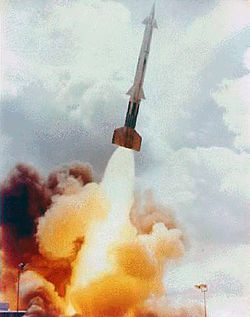Nike Zeus
| Nike Zeus B | |
|---|---|

Nike Zeus B test launch at White Sands
|
|
| Type | Anti-ballistic missile |
| Place of origin | United States |
| Service history | |
| Used by | US Army |
| Production history | |
| Manufacturer |
Bell Labs, Western Electric, Douglas Aircraft |
| Produced | 1961 |
| Specifications | |
| Weight | 24,200 lb (11,000 kg) total |
| Length | 50 feet 2 inches (15.29 m) total |
| Diameter | 36 inches (910 mm) |
|
Detonation
mechanism |
radio command |
|
|
|
| Engine | 450,000 lbf (2,000,000 N) booster |
|
Operational
range |
75 nmi (139 km; 86 mi) |
| Flight ceiling | over 150 nmi (280 km; 170 mi) |
| Speed | greater than Mach 4 |
|
Guidance
system |
command guidance |
|
Launch
platform |
silo |
Nike Zeus was an anti-ballistic missile (ABM) system developed by the US Army during the late 1950s and early 1960s, designed to destroy Soviet intercontinental ballistic missile warheads before they could hit targets in the United States. It was designed by Bell's Nike team, and was initially based on the earlier Nike Hercules anti-aircraft missile. The original Zeus A, given the tri-service identifier XLIM-49, was designed to intercept warheads in the upper atmosphere, mounting a 25 kiloton W31 nuclear warhead. During development, the concept changed to protect a much larger area and intercept the warheads at higher altitudes. This required the missile to be greatly enlarged into the totally new design, Zeus B, mounting a 400 kiloton W50 warhead. In several successful tests, the B model proved itself able to intercept warheads, and even satellites.
The nature of the strategic threat changed dramatically during the period that Zeus was being developed. Originally expected to face only a few dozen ICBMs, a nationwide defense was feasible, although expensive. In 1957, growing fears of a Soviet sneak attack led it to be repositioned as a way to protect Strategic Air Command's bomber bases, ensuring a retaliatory strike force would survive. But when the Soviets claimed to be building hundreds of missiles, the US faced the problem of building enough Zeus missiles to match them. The Air Force suggested they close this missile gap by building more ICBMs of their own instead. Adding to the debate, a number of technical problems emerged that suggested Zeus would have little capability against any sort of sophisticated attack.
...
Wikipedia
